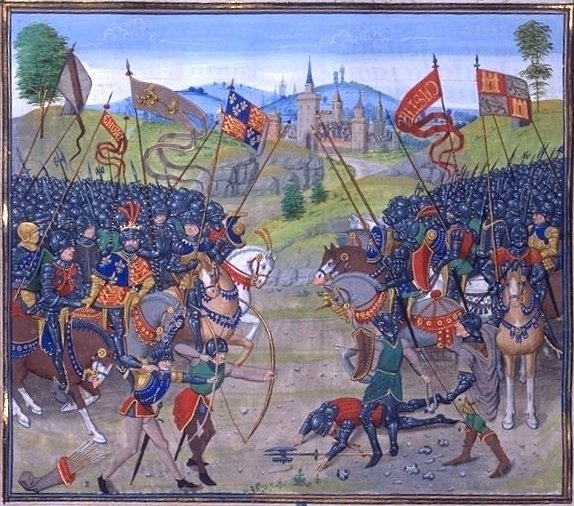Battle of Nájera, from a fifteenth-century manuscript, the English and Pedro are on the left.
(1362-1369)
The naval Battle of La Rochelle took place on 22 and 23 June 1372 between a Castilian fleet commanded by Ambrosio Boccanegra and an English convoy commanded by John Hastings, 2nd Earl of Pembroke. The Franco-Castilian fleet had been sent to attack the English at La Rochelle, which was being besieged by French forces. Besides Boccanegra, other Castilian commanders were Cabeza de Vaca, Fernando de Peón and Ruy Díaz de Rojas.
Pembroke had been dispatched to the town with a small retinue of 160 soldiers and instructions of recruit an army of 3,000 soldiers around Aquitaine. From 22 to 23 June both fleets clashed. The strength of the Castilian fleet was estimated between the 12 galleys given by the Castilian chronicler and naval captain López de Ayala and the 40 sailing ships and 13 barges mentioned by the French chronicler Jean Froissart, while the English convoy would probably consist of 20 vessels, of which just 3 were escort warships of towers and the other 17 are believed to be small barges of about 50 tons.
Thanks to their clear superiority both in ships and fighting men, the Castilians decisively defeated the English. Differing accounts from different historians exist about what actually transpired during the battle. These conflicts are mostly the work of nationalities; English, Castilian, and French historians described the battle in varying ways, emphasizing certain aspects but marginalizing others. Nevertheless, the victory was complete and the whole English convoy was destroyed. In his return to the Iberian Peninsula, Boccanegra captured four additional English ships.
#
Occurring during the nominal peace created by the Treaty of BRÉTIGNY, the disputed succession in the central Spanish kingdom of Castile provided the French and English Crowns with an opportunity to strike indirectly at each other’s interests. War in Spain also offered the governments of France and AQUITAINE a way to employ the bands of ROUTIERS ravaging their territories.
On the death of Alfonso XI in 1350, the Castilian Crown passed to his son, Pedro I (1334-69), who quickly acquired the epithet “the Cruel” by executing his father’s mistress, Leonor de Guzman. Leonor was the mother of ten children by the late king, and her death drove her eldest son, Henry of Trastámare (1333-79), to declare himself king and raise an unsuccessful rebellion against his half-brother. Although Henry fled Castile, Pedro revived his rival’s cause by executing several of Henry’s brothers and by quarreling with the Castilian Church, actions which won Henry support from the pope and the king of Aragon. In 1361, the mysterious death of Pedro’s French queen, Blanche of Bourbon, soured Castilian relations with France, where Pedro was suspected of poisoning his wife.
Fearful of the coalition building against him, Pedro sought an alliance with EDWARD III’s son, EDWARD, THE BLACK PRINCE, the ruler of English Aquitaine. To honor the Brétigny settlement, the prince agreed to provide military assistance solely as duke of Aquitaine and not as a representative of the English Crown. Besides a large sum of money, Pedro offered the prince a Castilian dukedom, tax exemptions for English merchants, and the hereditary right to lead armies into Castile. Henry, meanwhile, concluded a similar agreement with LOUIS, DUKE OF ANJOU, the brother of CHARLES V and king’s lieutenant in Languedoc. Largely comprised of routier bands from southern France, an army bearing the flag of Castile but led by the French constable Bertrand du GUESCLIN entered Castile in late 1365. Pedro immediately appealed to the prince, but the king’s support quickly dissolved and by April 1366 Pedro was in exile in Aquitaine and his rival was king of Castile as Henry II.
Although opposed by many of his advisors, the prince honored his agreement with Pedro and led an Anglo-Gascon army into Spain. After Edward’s attempts at mediation failed, the two sides met on 3 April 1367 at NÁJERA, where the prince won a major victory. Although Pedro was restored to power, his half-brother eluded capture and immediately renewed his alliance with Anjou, who hoped a friendly Castile would assist the French reconquest of Aquitaine. Unable to raise the money he owed, Pedro soon quarreled with the prince, who, ill and despairing of payment, withdrew to Aquitaine. With the increasingly open assistance of France, Henry of Trastámare launched a second invasion that concluded with Pedro’s death after the battle of Montiel in March 1369. Firmly allied with France, the new Castilian regime thereafter provided valuable naval support for French campaigns against Aquitaine and England.
Further Reading: Harvey, John. The Black Prince and His Age. London: Rowman and Littlefield, 1976; Hillgarth, J. N. The Spanish Kingdoms, 1250-1516. 2 vols. Oxford: Oxford University Press, 1976-78; O’Callaghan, James F. A History of Medieval Spain. Ithaca, NY: Cornell University Press, 1992; Russell, P. E. The English Intervention in Spain and Portugal in the Time of Edward III and Richard II. Oxford: Oxford University Press, 1955.
